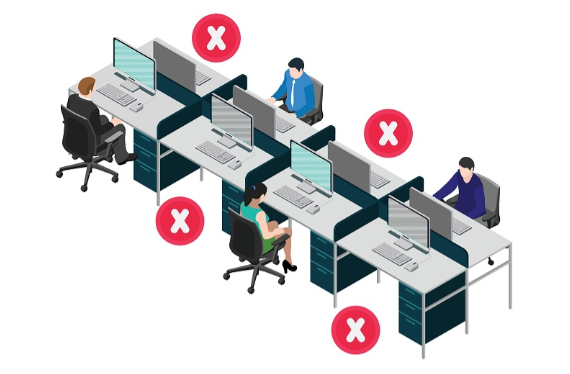The main obstacle for workplace and people analytics has been employees' discomfort with perceived surveillance and privacy. In general, the benefits of integrating this data and translating into enhanced workplace strategies may never be realised if employees continue to perceive a low value of providing the data and express high concerns with the use of these applications in the office.
As per the big changes brought about by COVID-19 in remote working, some similar changes could be realised in the way people will look at personal data privacy and surveillance, creating a window of opportunity. To ensure the acceptance of these technologies in the office environment, employers will have to aim at higher transparency and clarity of objectives while allowing employees to control the data they share with the company.
While COVID-19 has challenged the workplace paradigm, the global pandemic may have also opened the way for a new era of workplace analytics in which employees are at the centre of the story.
The city-state imposed “circuit-breaker” forced 80% of Singapore’s labor to work from home. As the community spread of the disease was slowly contained, plans for the gradual re-opening of the economy have been put in place. However, most employees are still encouraged to work from home for the foreseeable future to prevent the flare-up of the outbreak.
This seismic shift in the way we are working and living could become the new normal for the long-haul. The biggest social impact is the demise of direct face-to-face connection. Everything is done remotely as we try to practise social distancing - from team meetings, sales calls, engaging with customers, business training sessions, to Netflix watch parties and birthday celebrations on Zoom. This comes as a direct challenge to our human coded yearn for person-to-person connectivity and relationships.
We look into the challenges faced by leaders and teams today.
Working from Home
In a survey conducted by Qualtrics, only one in three employees in Singapore felt more productive since they started working from home.
Managers are often worried that remote employees are working less or are not fully focused on tasks at hand. Employees, on the other hand, are faced with many distractions and must exercise self-control to manage intrusions to stay motivated in achieving their goals.
As managers can’t keep tabs on remote workers the same way as when they are physically together in the office, they must develop a higher degree of trust. They are presented with the need to embrace potentially opposing leadership styles of empowerment or micromanaging. There is no one style that suits all employees but there is a shared need to recognize and accommodate visibility bias.

One answer to the challenge is to adopt mutually agreed and valued Key Performance Indicators (KPIs). It is an obvious but a necessary step to measure productivity rather than attendance. KPIs should be relevant or attainable otherwise employees will become frustrated and disengaged. Employees are more likely to reach their full potential when they are held accountable for attaining expected results.
Unlike going to a physical office, the ability to detach from work as the day ends is more difficult when working from home. The ubiquitous use of technology has led to an always-on mentality that often bleeds into personal time. This blurs the boundaries between work and life that can cause burnout.
Showing Empathy and Building Trust
Lack of trust in any organization is one of the biggest threats to business. Because the concept of trust is difficult to measure, some leaders before the pandemic didn't see it as an important factor that directly influences productivity and performance. That notion is now being challenged.
As employees continue to work remotely, managers and supervisors have begun to realize the value of promoting cooperation, open communications and loyalty within the group. That is only possible when a leader is able to build and foster trust. Bosses exhibiting empathy and showing vulnerability have positive effects on culture. It is the responsibility of leaders to develop emotional and financial trust especially when it comes to job security. It makes employees less anxious, more creative and more committed to the team and organizational goals.
New Social Norms
The rapid transition to remote work for majority of the population required the use of technology as the sole means of communication. This meant getting comfortable with video conferencing and forging strong and lasting relationships virtually instead of taking clients out on a fancy dinner or the often expensive business travel to meet prospects in person.
Although working from home has offered workers flexibility so they no longer have to endure long commutes, it unfortunately cannot replace the human connection, friendships and the sense of belonging that comes with physically coming to work. Not everyone can quickly adapt to this new normal and it can leave some employees feeling isolated and disconnected. They may become unsure of their roles and need more support and reassurance especially during times of stress and uncertainty.


Changing Behaviors
As people start to get used to the new normal, this reality of Covid-19 is changing behaviors from both a health and economic perspective. Their priorities are shifting to basic needs while discretionary spending is markedly decreased or put on hold.
More and more buyers are embracing online shopping even as brick-and-mortar stores start to reopen. Ancillary services such as pickup, delivery, and drive-through services are also seeing an uptick in adoption rates.
Because many people believe that there will be a global recession, they choose to be financially conservative. There is a trend towards paying more attention to purchasing decisions and the impact it has on the community. The winners will be those who can effectively communicate their value while continuing their contributions to society.
Effective Communications and Storytelling
Being social creatures, communication skills are essential in maintaining healthy relationships not only with immediate family but in our professional life as well. It allows for a more positive and collaborative work environment and has a strong correlation with employee engagement and productivity and ultimately, the bottom line.
This is the reason why great emphasis is placed on interpersonal skills and having the ability to tell compelling stories is invaluable to business. The new reality of remote work that teams are forced to live with has become more complex and challenging. This can lead to ambiguity and misunderstandings.
Effective communication is also key in keeping employees engaged and in building a positive and supportive culture. Without having solid storytelling skills, engaging, motivating and inspiring your team will be close to impossible.

Why Storytelling Matters in Finance
Due to the pandemic, leading teams, building meaningful relationships, fostering trust, and driving productivity have become challenging. To counter anxiety and fear requires consistent, clear and effective communications. Powerful Storytelling helps leaders and teams navigate uncertainty and changes brought about by the pandemic.
While storytelling is often thought of as a soft skill for the creative professionals, it is as much a desirable and crucial skill in managers and leaders in the financial industry. Various studies have shown that telling a story has a much greater probability of being remembered compared to merely providing statistics. Statistics and hard data are what information business leaders rely on to make vital decisions but numbers often fall flat and fail to show the complete picture without proper context.
Here are a few Storytelling workplace applications:
Building Relationships with Clients
Storytelling can be used to establish rapport and gain credibility with clients. Stories can show clients that you understand and can relate with their challenges. Sharing well documented customer success stories helps clients visualize how you can pave the path to their goals and desired outcomes.
Mitigating Risks
Storytelling can provide context when illustrating risks during the introduction of new policies and to encourage compliance. It provides a more compelling method to change behaviour than just presenting facts and figures.
Marketing Products and Services
Storytelling can be employed to show benefits of financial products and services especially when explaining complex offerings. Through stories, you can strengthen the emotional bond with your brand increasing conversions and improving retention.
Customer Experience Management
Storytelling can be employed as part of your customer experience strategy. It helps teams understand the customer journey and humanizes their experience.
Why Storytelling Works - The Science Behind It
Neuroscientist Uri Hasson has extensively researched the basis of human communication and storytelling. He found out that when telling a story, the brains of the speaker and listener synchronize. Two things happen:
- The listener's brain becomes physically coupled to the sound wave you are transmitting
- Mirror neurons, that help to create the experience of empathy, are triggered
Oxytocin Neurochemical
Paul J. Zak of the Center for Neuroeconomics Studies, discovered that stories increase the release of oxytocin in the brain. This is a neurochemical that is produced when we are trusted or are shown kindness. Oxytocin enhances the sense of empathy and our ability to experience other people's emotions. By "hacking" the brain, stories can motivate people to engage in cooperative behaviors.

Dopamine Neurochemical
Why are stories more effective than Powerpoint presentations? In his book Brain Rules, John Medina explains this phenomenon: “When the brain detects an emotionally charged event, the amygdala releases dopamine into the system. Because dopamine greatly aids memory and information processing, you could say it creates a Post It note that reads, ‘Remember this'. This is why you can often remember a story from 3 years ago, but maybe not the whole Powerpoint presentation from last week..."
Storytelling Can Make a Difference
Singapore has long established itself as a progressive global financial hub that serves both the local economy and the Asia Pacific region. As an international financial center, it is home to over 1,200 financial institutions that offer a myriad of products and services across diverse asset classes.
Aside from an efficient, pro-business and well-regulated financial environment, the city state also boasts of highly skilled and experienced finance professionals.
However, the banking and finance ecosystem is in a state of transformation. Because of the current crisis, the sector is facing rapid digitization, stricter regulations, increased risks and more demanding consumers. To maintain a strong and competitive banking industry, soft skills such as communications must also be strengthened.
Covid-19 has forced workers to change the way they work almost overnight. Finance professionals must now figure out how to adapt to rapidly changing conditions, new roles and dynamic processes. Storytelling is the foundation that will help individuals and organizations weather the storm.

 Overview
Overview



















